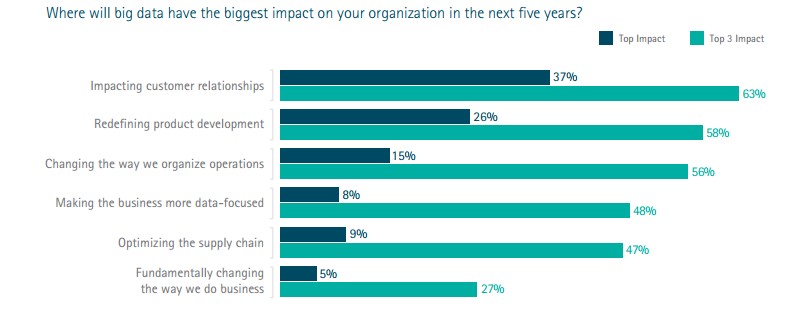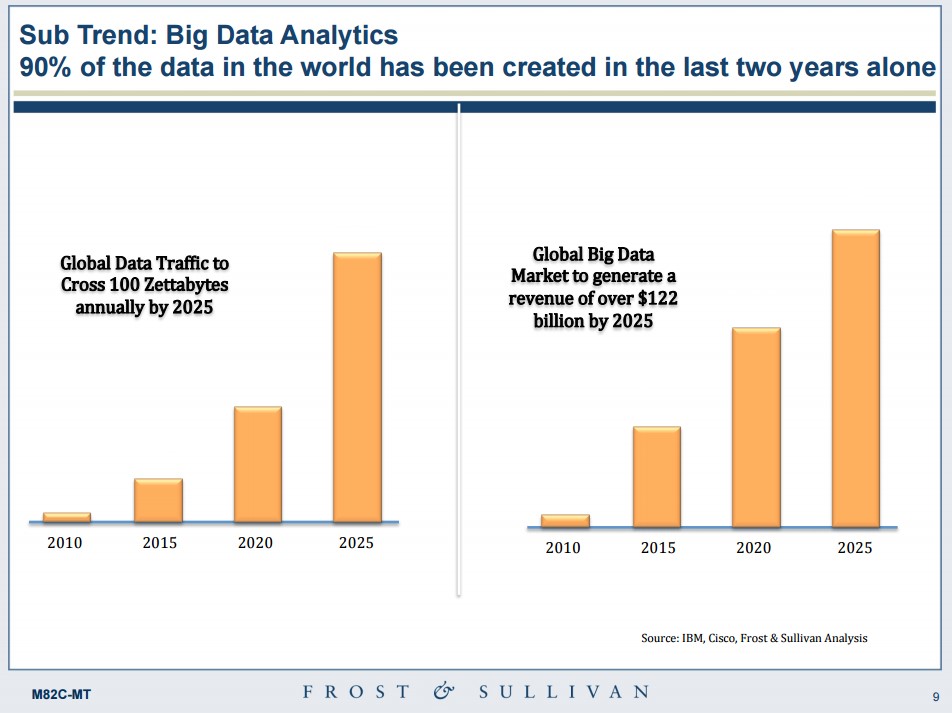(c)iStock.com/alexsl
Despite the varying methodologies used in the studies mentioned in this roundup, many share a common set of conclusions. The high priority in gaining greater insights into customers and their unmet needs, more precise information on how to best manage and simplify sales cycles, and how to streamline service are common themes.
- Salesforce (NYSE:CRM) estimates adding analytics and Business Intelligence (BI) applications will increase their Total Addressable Market (TAM) by $13B in FY2014.
- 89% of business leaders believe Big Data will revolutionize business operations in the same way the Internet did.
- 83% have pursued Big Data projects in order to seize a competitive edge.
The most successful Big Data uses cases revolve around enterprises’ need to get beyond the constraints that hold them back from being more attentive and responsive to customers.
Presented below is a roundup of recent forecasts and estimates:
- Wikibon projects the Big Data market will top $84B in 2026, attaining a 17% Compound Annual Growth Rate (CAGR) for the forecast period 2011 to 2026. The Big Data market reached $27.36B in 2014, up from $19.6B in 2013. These and other insights are from Wikibon’s excellent research of Big Data market adoption and growth. The graphic below provides an overview of their Big Data Market Forecast. Source: Executive Summary: Big Data Vendor Revenue and Market Forecast, 2011-2026.

- IBM and SAS are the leaders of the Big Data predictive analytics market according to the latest Forrester Wave™: Big Data Predictive Analytics Solutions, Q2 2015. The latest Forrester Wave is based on an analysis of 13 different big data predictive analytics providers including Alpine Data Labs, Alteryx, Angoss Software, Dell, FICO, IBM, KNIME.com, Microsoft, Oracle, Predixion Software, RapidMiner, SAP, and SAS. Forrester specifically called out Microsoft Azure Learning is an impressive new entrant that shows the potential for Microsoft to be a significant player in this market. Gregory Piatetsky (@KDNuggets) has done an excellent analysis of the Forrester Wave Big Data Predictive Analytics Solutions Q2 2015 report here. Source: Courtesy of Predixion Software: The Forrester Wave™: Big Data Predictive Analytics Solutions, Q2 2015 (free, no opt-in).

- IBM, KNIME, RapidMiner and SAS are leading the advanced analytics platform market according to Gartner’s latest Magic Quadrant. Gartner’s latest Magic Quadrant for advanced analytics evaluated 16 leading providers of advanced analytics platforms that are used to building solutions from scratch. The following vendors were included in Gartner’s analysis: Alpine Data Labs, Alteryx, Angoss, Dell, FICO, IBM, KNIME, Microsoft, Predixion, Prognoz, RapidMiner, Revolution Analytics, Salford Systems, SAP, SAS and Tibco Software, Gregory Piatetsky (@KDNuggets) provides excellent insights into shifts in Magic Quadrant for Advanced Platform rankings here. Source: Courtesy of RapidMiner: Magic Quadrant for Advanced Analytics Platforms Published: 19 February 2015 Analyst(s): Gareth Herschel, Alexander Linden, Lisa Kart (reprint; free, no opt-in).

- Salesforce estimates adding analytics and Business Intelligence (BI) applications will increase their Total Addressable Market (TAM) by $13B in FY2014. Adding new apps in analytics is projected to increase their TAM to $82B for calendar year (CY) 2018, fueling an 11% CAGR in their total addressable market from CY 2013 to 2018. Source: Building on Fifteen Years of Customer Success Salesforce Analyst Day 2014 Presentation (free, no opt in).

- 89% of business leaders believe big data will revolutionize business operations in the same way the Internet did. 85% believe that big data will dramatically change the way they do business. 79% agree that ‘companies that do not embrace Big Data will lose their competitive position and may even face extinction.’ 83% have pursued big data projects in order to seize a competitive edge. The top three areas where big data will make an impact in their operations include: impacting customer relationships (37%); redefining product development (26%); and changing the way operations is organized (15%).The following graphic compares the top six areas where big data is projected to have the greatest impact in organizations over the next five years. Source: Accenture, Big Success with Big Data: Executive Summary (free, no opt in).

- The global Big Data market is projected reach $122B in revenue by 2025. Frost & Sullivan also forecasts the global data traffic will cross 100 Zettabytes annually by 2025. Source: World’s Top Global Mega Trends To 2025 and Implications to Business, Society and Cultures.

- The global text analytics market has a potential to reach $6.5B by 2020, attaining a CAGR of 25.2% from 2014 to 2020. Customer Relationship Management (CRM), predictive analytics and brand reputation are the top three projected applications. The following graphic provides an overview of key findings from the report. Source: Global Text Analytics Market: Text Analytics, Visualizing and Analyzing Open-Ended Text Data.

- Customer analytics (48%), operational analytics (21%), and fraud & compliance (21%) are the top three use cases for Big Data. Datameer’s analysis of the market also found that the global Hadoop market will grow from $1.5B in 2012 to $50.2B in 2020, and financial services, technology and telecommunications are the leading industries using big data solutions today. Source: Big Data: A Competitive Weapon for the Enterprise.

- 37% of Asia Pacific manufacturers are using Big Data and analytics technologies to improve production quality management. IDC found manufacturers in this region are relying on these technologies to reduce costs, increase productivity, and attract new customers. Source: Big Data and Analytics Core to Nex-Gen Manufacturing.

- Supply chain visibility (56%), geo-location and mapping data (47%) and product traceability data (42%) are the top three potential areas of Big Data opportunity for supply chain management. Transport management, supply chain planning, & network modeling and optimization are the three most popular applications of Big Data in supply chain initiatives. Source: Supply Chain Report, February 2015.

- Finding correlations across multiple disparate data sources (48%), predicting customer behavior (46%) and predicting product or services sales (40%) are the three factors driving interest in Big Data analytics. These and other fascinating findings from InformationWeek’s 2015 Analytics & BI Survey provide a glimpse into how enterprises are selecting analytics applications and platforms. Source: Information Week 2015 Analytics & BI Survey.

- Banking, communications, media, utilities and wholesale trade increased their use of Big Data analytics the most in the last twelve months. Gartner’s latest survey of big data adoption completed in the fourth quarter of 2014 found that columnar/in-memory databases, high-capacity data warehouses, search-based indexes and log data analytics all experienced greater than 5% growth in references reporting active use. Source: Survey Analysis: BI and Analytics Spending Intentions, 2015, 13 May 2015, Report G00274741 Analyst(s): Josh Parenteau & Rita L. Sallam (client access).
- IDC predicts the global Big Data and Analytics market will reach $125B in hardware, software and services revenue this year. The professional services-to-technology ratio will also increase 25% this year, due to increasingly complex system configurations and enterprise-wide solutions. IDC also predicts the Internet of Things (IoT) market will also attain a 30% CAGR from 2014 to 2019. Source: IDC Predictions 2015: Accelerating Innovation — and Growth — on the 3rd Platform by Frank Gens & IDC Predictions 2015 Team (free, no opt-in courtesy of SAP).
Gartner does not endorse any vendor, product or service depicted in its research publications, and does not advise technology users to select only those vendors with the highest ratings. Gartner research publications consist of the opinions of Gartner’s research organization and should not be construed as statements of fact. Gartner disclaims all warranties, expressed or implied, with respect to this research, including any warranties of merchantability or fitness for a particular purpose.